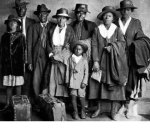For even more information on August Wilson and the world of the play, check out our Piano Lesson Context Guide–or better yet, pick up a paper copy during one of our performances.
Tag Archives: reading
‘Genesis’ Series, by Jacob Lawrence
Jacob Lawrence’s Genesis Series (1990) describes a passage from the book of Genesis in the King James version of the Bible. The series reflects Lawrence’s youthful memories of passionate sermons about the Creation given by ministers at the Abyssinian Baptist Church in Harlem where he was baptized in 1932. The selections from this series, along with the final painting in this gallery, There are Many Churches in Harlem, paint a visual picture of the Christian world Avery hopes to build within his new community in the Hill District, and the world in which he and Berniece have integrated themselves.
- There are Many Churches in Harlem
August Wilson’s Five Beliefs
According to Dr. Sandra Shannon in her book The Dramatic Vision of August Wilson, the playwright had five primarily beliefs by which he stood, all of which are evident in each of his ten Century Cycle plays. The beliefs are:
1.The original sin committed by African Americans may be traced back to their massive postwar exodus from the South and their decision not to cling to the land.
2. African Americans do not sufficiently acknowledge and celebrate their cultural differences.
3. The salvation of today’s African Americans rests with renewing ties with Africa and acknowledging their african heritage.
4. Mainstream histories have systematically and consciously excluded and misrepresented African-Americans.
5. The only venues that traditionally have offered African Americans limited acceptance have been sports and music.
Artist Spotlight: Jamil Jude, Director
 Maegan Clearwood, Dramaturg: You have a strong background in new play development as opposed to classics, so can you tell me a little about how you came to this position as a director?
Maegan Clearwood, Dramaturg: You have a strong background in new play development as opposed to classics, so can you tell me a little about how you came to this position as a director?
Jamil Jude, Director: Jason [Loewith] has known me for about five years through National New Play Network. I think he’s seen me as a young director, a young theatre artist through NNPN, but also as someone who had a deep interest in telling stories, especially people from African diaspora. During my time at Arena Stage, I got the opportunity to work with a lot of people who are interpreting August Wilson’s work, and I found a connection inside of it. It’s like one of those life-affirming moments: I was in a rehearsal hall, surrounded by people who had worked on August Wilson’s plays, and in that moment I felt like, “Oh, okay, my stories are important to American theatre.”
MC: What are some of the themes that you really like to explore as a director?
JJ: I’m all into character relationships. I try not to say that I like love stories, but I do, I can’t get away from that. Anytime there’s a play where two warring factions both have equal voice, those are my favorites. I read a historical play yesterday, so obviously you know who wins, but the playwright did such a good job at making the loser inevitably be the loser that it just wasn’t fun. So I love issues of ambiguity, so that when I walk out, I wasn’t told whose side I should be on, I was told to think about these issues in maybe a way I never thought about before.
Various genres of African-American music are at the forefront of all of August Wilson’s plays, and The Piano Lesson is no exception. In it, the characters explore three main styles of music: prison work songs, the boogie-woogie, and, one of Wilson’s most significant influences, the blues:
“The music is a specific cultural response of black America to the world, the circumstances and the situation in which they’ve found themselves… If you didn’t know anything about African people and nothing about black people in America, and someone gave you blues records, you could listen and find out what kind of people these were … their symmetry, this grace … you’d be able to construct their daily lives.”
The Piano as a Character
“The very validity of the word ‘inanimate’ is called into question in this play, especially as it pertains to the large, sound-producing, dominant physical object that is the piano. If the root word anima refers to that which has breath, spirit, or life (Webster’s also lists anima as ‘soul’ while Jung regards anima as the true inner self of the individual, as opposed to persona), then the piano that plays on its own is animate, not inanimate. Its alive qualities are what keeps Berniece from touching it, for fear of waking the spirits.”
—Nomos, Mysticism, and Power Objects in August Wilson’s “Joe Turner’s Come and Gone,” “Gem of the Ocean,” and The Piano Lesson,” by Marian Wolbers
The Truck as an ‘Offstage Character’
Excerpted from Toni Morrison’s introduction to The Piano Lesson
“This truck full of watermelons is not just the play’s mobility–it is also a kind of offstage character with its own colorful personality and multiple roles.
[Lymon and Boy Willie] take pride in being able to repair it as it breaks down three times on the way to Pittsburgh and several times after its arrival. In spite of their frustrations, their industry pays off and they are able to get to a neighborhood where they can sell their watermelons. The produce the truck holds is convenient and symbolic, since watermelons are iconographically and comically related to black people. Yet thei represent the best kind of self-help. The truck’s break-down journey is as interesting as its passengers. It has been home and hiding place for Lymon and a double necessity to Boy Willie’s project; he expects its bed to hold two sources of income–selling produce and transporting the valuable piano. Finally, its exit enables a couple, Lymon and Grace, bent on being one, to escape; and it forces Boy Willie to abandon his goal, with no option but to take the train home.
The truck bears a heavy weight as symbol and dramatic glue. Integral to the action, it sits offstage but not off page, where it stokes the imagination. What color is it? What make? What is its mechanical problem? What is its future? What will become of it and Lymon and Grace? Like a magic carpet it arrives, solves problems, and disappears with lovers aboard. The time such rumination take and the pleasure they summon are most available in reading.
“We were land-based agrarian people from Africa. We were uprooted from Africa, and we spent 200 years developing our culture as black Americans. And then we left the South. We uprooted ourselves and attempted to transplant this culture to the pavements of the industrialized North. And it was a transplant that did not take. I think if we had stayed in the South, we would have been a stronger people. And because the connection between the South of the 20’s, 30’s and 40’s has been broken, it’s very difficult to understand who we are.” — August Wilson
Images of the Great Migration
The Great Migration serves as the catalyst for arguably all of August Wilson’s works, but it is at the very heart of The Piano Lesson. Each of its characters grapple with their personal place in the enormous movement, from Berniece, who fled the South after her husband’s violent death, to Boy Willie, who refuses to abandon his native land. These simple yet haunting images of the Migration create a snapshot into the epic journey itself, a path that more than 6 million African Americans made in the hopes of securing a safer and better life.
August Wilson on Playwriting
I start with the decade. I know some things when I start. I know, let’s say, that the play is going to be a 1970s or a 1930s play, and it’s going to be about a piano, but that’s it. I slowly discover who the characters are as I go along. In The Piano Lesson, for instance, the question I had was, “Can you acquire a sense of self-worth by denying your past?” So I said, “Okay, let me invent this situation and place characters on stage who ask that question. They don’t necessarily have to answer it, but let’s pose the question.” So I know I want to do that, but how I’m going to do that I very often don’t know. I do know some things before I start.
Excerpted from an interview by Elisabeth J. Heard, published in the African American Review, Vol. 35, No. 1, Spring 2001.








